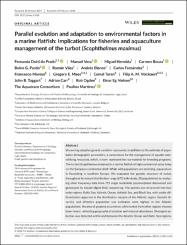| dc.contributor.author | do Prado, Fernanda Dotti | |
| dc.contributor.author | Vera, Manuel | |
| dc.contributor.author | Hermida, Miguel | |
| dc.contributor.author | Bouza, Carmen | |
| dc.contributor.author | Pardo, Belen G. | |
| dc.contributor.author | Vilas, Roman | |
| dc.contributor.author | Blanco, Andres | |
| dc.contributor.author | Fernandez, Carlos | |
| dc.contributor.author | Maroso, Francesco | |
| dc.contributor.author | Maes, Gregory E. | |
| dc.contributor.author | Turan, Cemal | |
| dc.contributor.author | Volckaert, Filip A. M. | |
| dc.contributor.author | Taggart, John B. | |
| dc.contributor.author | Carr, Adrian | |
| dc.contributor.author | Ogden, Rob | |
| dc.contributor.author | Nielsen, Einar Eg | |
| dc.contributor.author | Martinez, Paulino | |
| dc.date.accessioned | 12.07.201910:50:10 | |
| dc.date.accessioned | 2019-07-12T22:06:05Z | |
| dc.date.available | 12.07.201910:50:10 | |
| dc.date.available | 2019-07-12T22:06:05Z | |
| dc.date.issued | 2018 | |
| dc.identifier.citation | do Prado, F. D., Vera, M., Hermida, M., Bouza, C., Pardo, B. G., Vilas, R., Blanco, A., Fernández, C., Maroso, F., Maes, G. E., Turan, C., Volckaert, F. A. M., Taggart, J. B., Carr, A., Ogden, R., Nielsen, E. E., Martínez, P. (2018). Parallel evolution and adaptation to environmental factors in a marine flatfish: Implications for fisheries and aquaculture management of the turbot (Scophthalmus maximus). Evolutionary Applications,
11(8), 1322-1341. doi: 10.1111/eva.12628 | en_US |
| dc.identifier.issn | 1752-4571 | |
| dc.identifier.uri | https://doi.org/10.1111/eva.12628 | |
| dc.identifier.uri | https://hdl.handle.net/20.500.12508/637 | |
| dc.description | WOS: 000442210300011 | en_US |
| dc.description | 30151043 | en_US |
| dc.description | Science Citation Index Expanded | en_US |
| dc.description.abstract | Unraveling adaptive genetic variation represents, in addition to the estimate of population demographic parameters, a cornerstone for the management of aquatic natural living resources, which, in turn, represent the raw material for breeding programs. The turbot (Scophthalmus maximus) is a marine flatfish of high commercial value living on the European continental shelf. While wild populations are declining, aquaculture is flourishing in southern Europe. We evaluated the genetic structure of turbot throughout its natural distribution range (672 individuals; 20 populations) by analyzing allele frequency data from 755 single nucleotide polymorphism discovered and genotyped by double-digest RAD sequencing. The species was structured into four main regions: Baltic Sea, Atlantic Ocean, Adriatic Sea, and Black Sea, with subtle differentiation apparent at the distribution margins of the Atlantic region. Genetic diversity and effective population size estimates were highest in the Atlantic populations, the area of greatest occurrence, while turbot from other regions showed lower levels, reflecting geographical isolation and reduced abundance. Divergent selection was detected within and between the Atlantic Ocean and Baltic Sea regions, and also when comparing these two regions with the Black Sea. Evidence of parallel evolution was detected between the two low salinity regions, the Baltic and Black seas. Correlation between genetic and environmental variation indicated that temperature and salinity were probably the main environmental drivers of selection. Mining around the four genomic regions consistently inferred to be under selection identified candidate genes related to osmoregulation, growth, and resistance to diseases. The new insights are useful for the management of turbot fisheries and aquaculture by providing the baseline for evaluating the consequences of turbot releases from restocking and farming. | en_US |
| dc.description.sponsorship | 7th Framework Programme for research (FP7) under "Knowledge-Based Bio-Economy - KBBE", Theme 2: "Food, Agriculture and fisheries, and Biotechnologies" [FP7-KBBE-2012-6-singlestage, 311920]; Spanish Regional Government Xunta de Galicia [GRC2014/010] | en_US |
| dc.description.sponsorship | 7th Framework Programme for research (FP7) under "Knowledge-Based Bio-Economy - KBBE", Theme 2: "Food, Agriculture and fisheries, and Biotechnologies" Project identifier: FP7-KBBE-2012-6-singlestage, Grant/Award Number: 311920; Spanish Regional Government Xunta de Galicia, Grant/Award Number: GRC2014/010 | en_US |
| dc.language.iso | eng | en_US |
| dc.publisher | Wiley-Blackwell | en_US |
| dc.relation.isversionof | 10.1111/eva.12628 | en_US |
| dc.rights | info:eu-repo/semantics/openAccess | en_US |
| dc.subject | Adaptive Variation | en_US |
| dc.subject | Conservation Genetics | en_US |
| dc.subject | Population Structure | en_US |
| dc.subject | RAD Sequencing | en_US |
| dc.subject.classification | Evolutionary Biology | en_US |
| dc.subject.classification | Gadus morhua | Spawning | Marine fish | en_US |
| dc.subject.other | bass dicentrarchus-labrax | en_US |
| dc.subject.other | life-history traits | en_US |
| dc.subject.other | population-structure | en_US |
| dc.subject.other | baltic sea | en_US |
| dc.subject.other | genome-scan | en_US |
| dc.subject.other | 3-spined sticklebacks | en_US |
| dc.subject.other | allozyme variation | en_US |
| dc.subject.other | re-implementation | en_US |
| dc.subject.other | genetic-variation | en_US |
| dc.subject.other | wild populations | en_US |
| dc.title | Parallel evolution and adaptation to environmental factors in a marine flatfish: Implications for fisheries and aquaculture management of the turbot (Scophthalmus maximus) | en_US |
| dc.type | article | en_US |
| dc.relation.journal | Evolutionary Applications | en_US |
| dc.contributor.department | Deniz Bilimleri ve Teknolojisi Fakültesi -- Deniz Bilimleri Bölümü | en_US |
| dc.contributor.authorID | 0000-0003-1584-6140 | en_US |
| dc.contributor.authorID | 0000-0002-9501-4506 | |
| dc.contributor.authorID | 0000-0001-8438-9305 | |
| dc.contributor.authorID | 0000-0003-0327-9521 | |
| dc.contributor.authorID | 0000-0001-9584-0261 | |
| dc.contributor.authorID | 0000-0003-3548-6306 | |
| dc.contributor.authorID | 0000-0002-3064-1218 | |
| dc.contributor.authorID | 0000-0002-1531-7321 | |
| dc.contributor.authorID | 0000-0002-3843-9663 | |
| dc.identifier.volume | 11 | en_US |
| dc.identifier.issue | 8 | en_US |
| dc.identifier.startpage | 1322 | en_US |
| dc.identifier.endpage | 1341 | en_US |
| dc.relation.publicationcategory | Makale - Uluslararası Hakemli Dergi - Kurum Öğretim Elemanı | en_US |
| dc.contributor.isteauthor | Turan, Cemal | |
| dc.relation.index | Web of Science - Scopus - PubMed | en_US |
| dc.relation.index | Web of Science Core Collection - Science Citation Index Expanded | |
















